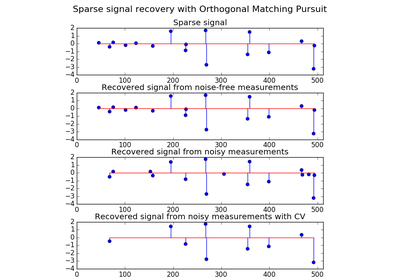3.2.4.1.8. sklearn.linear_model.OrthogonalMatchingPursuitCV¶
-
class
sklearn.linear_model.OrthogonalMatchingPursuitCV(copy=True, fit_intercept=True, normalize=True, max_iter=None, cv=None, n_jobs=1, verbose=False)[源代码]¶ Cross-validated Orthogonal Matching Pursuit model (OMP)
Parameters: copy : bool, optional
Whether the design matrix X must be copied by the algorithm. A false value is only helpful if X is already Fortran-ordered, otherwise a copy is made anyway.
fit_intercept : boolean, optional
whether to calculate the intercept for this model. If set to false, no intercept will be used in calculations (e.g. data is expected to be already centered).
normalize : boolean, optional
If False, the regressors X are assumed to be already normalized.
max_iter : integer, optional
Maximum numbers of iterations to perform, therefore maximum features to include. 10% of
n_featuresbut at least 5 if available.cv : int, cross-validation generator or an iterable, optional
Determines the cross-validation splitting strategy. Possible inputs for cv are:
- None, to use the default 3-fold cross-validation,
- integer, to specify the number of folds.
- An object to be used as a cross-validation generator.
- An iterable yielding train/test splits.
For integer/None inputs,
KFoldis used.Refer User Guide for the various cross-validation strategies that can be used here.
n_jobs : integer, optional
Number of CPUs to use during the cross validation. If
-1, use all the CPUsverbose : boolean or integer, optional
Sets the verbosity amount
Read more in the :ref:`User Guide <omp>`. :
Attributes: intercept_ : float or array, shape (n_targets,)
Independent term in decision function.
coef_ : array, shape (n_features,) or (n_features, n_targets)
Parameter vector (w in the problem formulation).
n_nonzero_coefs_ : int
Estimated number of non-zero coefficients giving the best mean squared error over the cross-validation folds.
n_iter_ : int or array-like
Number of active features across every target for the model refit with the best hyperparameters got by cross-validating across all folds.
参见
orthogonal_mp,orthogonal_mp_gram,lars_path,Lars,LassoLars,OrthogonalMatchingPursuit,LarsCV,LassoLarsCV,decomposition.sparse_encodeMethods
decision_function(*args, **kwargs)DEPRECATED: and will be removed in 0.19. fit(X, y)Fit the model using X, y as training data. get_params([deep])Get parameters for this estimator. predict(X)Predict using the linear model score(X, y[, sample_weight])Returns the coefficient of determination R^2 of the prediction. set_params(**params)Set the parameters of this estimator. -
__init__(copy=True, fit_intercept=True, normalize=True, max_iter=None, cv=None, n_jobs=1, verbose=False)[源代码]¶
-
decision_function(*args, **kwargs)[源代码]¶ DEPRECATED: and will be removed in 0.19.
Decision function of the linear model.
Parameters: X : {array-like, sparse matrix}, shape = (n_samples, n_features)
Samples.
Returns: C : array, shape = (n_samples,)
Returns predicted values.
-
fit(X, y)[源代码]¶ Fit the model using X, y as training data.
Parameters: X : array-like, shape [n_samples, n_features]
Training data.
y : array-like, shape [n_samples]
Target values.
Returns: self : object
returns an instance of self.
-
get_params(deep=True)[源代码]¶ Get parameters for this estimator.
Parameters: deep: boolean, optional :
If True, will return the parameters for this estimator and contained subobjects that are estimators.
Returns: params : mapping of string to any
Parameter names mapped to their values.
-
predict(X)[源代码]¶ Predict using the linear model
Parameters: X : {array-like, sparse matrix}, shape = (n_samples, n_features)
Samples.
Returns: C : array, shape = (n_samples,)
Returns predicted values.
-
score(X, y, sample_weight=None)[源代码]¶ Returns the coefficient of determination R^2 of the prediction.
The coefficient R^2 is defined as (1 - u/v), where u is the regression sum of squares ((y_true - y_pred) ** 2).sum() and v is the residual sum of squares ((y_true - y_true.mean()) ** 2).sum(). Best possible score is 1.0 and it can be negative (because the model can be arbitrarily worse). A constant model that always predicts the expected value of y, disregarding the input features, would get a R^2 score of 0.0.
Parameters: X : array-like, shape = (n_samples, n_features)
Test samples.
y : array-like, shape = (n_samples) or (n_samples, n_outputs)
True values for X.
sample_weight : array-like, shape = [n_samples], optional
Sample weights.
Returns: score : float
R^2 of self.predict(X) wrt. y.


